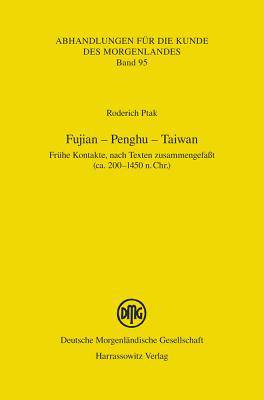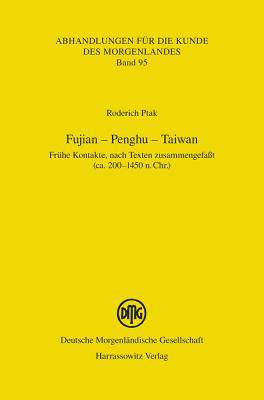
- Retrait en 2 heures
- Assortiment impressionnant
- Paiement sécurisé
- Toujours un magasin près de chez vous
- Retrait gratuit dans votre magasin Club
- 7.000.0000 titres dans notre catalogue
- Payer en toute sécurité
- Toujours un magasin près de chez vous
Fujian - Penghu - Taiwan
Fruhe Kontakte, Nach Texten Zusammengefasst (Ca. 200-1450 N.Chr.)
Roderich Ptak
Livre broché | Allemand
74,95 €
+ 149 points
Description
English summary: Archaeologists have shown that Taiwan and the Penghu Islands had contact with the Chinese mainland and other regions at a fairly early date. The goal of this book, however, is to present a critical overview of relevant evidence from ancient written sources (ca. from the Han to the early Ming period), predominantly organized according to chronology. Much evidence remains controversial to this day, in part because of issues with exact place names, but the aggregate implies that Penghu and Taiwan were acknowledged by the mainland societies, above all in Fujian, and they occasionally even played important roles in the political and military calculations of those societies. We can therefore talk about the origins of "globalization" in Asia long before the appearance of the first Europeans in mainland China. Briefly, the topical focus shifts from the mainland to the insular region with the result that Taiwan is placed within the greater maritime context as an island which sits in the exchange zones between the East and South China Seas. This context was very important in the development of traditional sea-routes, especially the so-called "east route" from Fujian by way of Penghu in the direction of Luzon, the region of the Sulu-Zone between the Philippines and Indonesia, and even further south. This work is intended as an introduction suitable for both historians as well as students. German description: Archaologen haben gezeigt, dass Taiwan und die Penghu-Inseln schon fruh mit dem chinesischen Festland und anderen Gebieten in Kontakt standen. Hier geht es jedoch um entsprechende Belege in alten Schriftquellen (ca. Han- bis fruhe Ming-Periode), die in einer kritischen Gesamtschau, uberwiegend chronologisch geordnet, vorgestellt werden. Viele Hinweise sind bis heute umstritten, etwa bestimmte Toponyme, aber in der Summe deuten sie an, dass Penghu und Taiwan vor allem in Fujian wahrgenommen wurden, bisweilen sogar im politisch-militarischen Kalkul des Festlandes eine gewisse Rolle spielten - und zwar schon lange vor Ankunft der ersten Europaer in Fernost und dem Beginn der "Globalisierung". Kurz, der Blick wandert vom Festland auf die insulare Region. Dabei wird Taiwan zugleich in grossere maritime Kontexte eingebettet: als Insel, die zwischen den Austauschzonen des Ost- und Sudchinesischen Meeres lag. Sehr wichtig in diesem Zusammenhang ist die Entwicklung traditioneller Seerouten, besonders der sogenannten Ostroute von Fujian via Penghu in Richtung Luzon, der Sulu-Zone und noch weiter nach Suden. Insgesamt ist die Darstellung als Einfuhrung konzipiert, die nicht nur Historiker, sondern auch Studierende anspricht.
Spécifications
Parties prenantes
- Auteur(s) :
- Editeur:
Contenu
- Nombre de pages :
- 152
- Langue:
- Allemand
Caractéristiques
- EAN:
- 9783447103596
- Date de parution :
- 30-03-15
- Format:
- Livre broché
- Format numérique:
- Trade paperback (VS)
- Dimensions :
- 145 mm x 218 mm
- Poids :
- 439 g

Seulement chez Librairie Club
+ 149 points sur votre carte client de Librairie Club
Les avis
Nous publions uniquement les avis qui respectent les conditions requises. Consultez nos conditions pour les avis.








